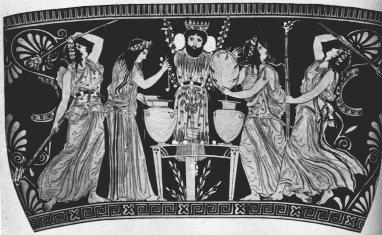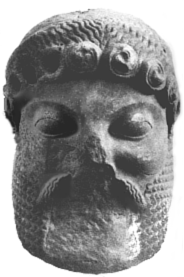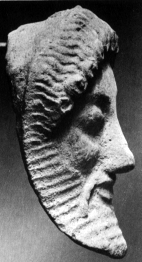

The Lênaia, which is held at the coldest time of year (c. Jan 28-31), is for Dionysos Lênaios, and celebrates His birth from Zeus's thigh and His emergence from the Underworld. He was conceived at the time of the Lesser Mysteries at Agrai (late Feb), and grew in the womb of Semele (who is Persephone) for 7 months, before Zeus blasted Her and rescued the Divine child, born in death. This was at the time of the Greater (Eleusinian) Mysteries (c. Sep 29 - Oct 5) and of the grape harvest. During the same period (Oct - Jan) that Dionysos was the Sewed-in One (Eiraphiôtês), the wine has fermented in buried jugs. Now, at the time when the Divine Child emerged from Zeus, at the coldest time, the wine has cleared, and it also will be brought out of the Earth, at this time also when Dionysos emerged from the Underworld. Therefore we celebrate at once Dionysos' emergence from the Underworld and His birth as Divine Child. God and Wine together manifest a miraculous rebirth.
The Lênaia is held under the full moon on the 12th of Gamêliôn. (Nominally, this is c. Jan. 28, so generally the best time for the Lênaia is the full moon nearest Feb. 1, or, we might say, the full moon following the full moon nearest the winter solstice.) Gamêliôn is the month for marriage (gamos), because in the Anthestêria (c. Feb. 25-27) - the wedding of Dionysos - new brides will want to unite with the Indestructible Life of Dionysos. This month is also called Lênaion, for the Lênaia, and Eiraphion, because it is the month when the Sewed-in God appears. Yesterday (11 Gamêliôn), many of us made sacrifice to Semele as mother of the Divine Child. (Her resurrection from the Underworld and ascent to Heaven will be celebrated in the Herois, the mysteries of the resurrection of Semele as Heroine.) Purified by Heavenly Fire, She ascended to the Gods.
Next come the twice-seven Gerairai, the college (thiasos) of Venerable Women, priestesses sworn in by the Basilenna, the religious "Queen" (wife of the Basileus, who will give her to the God in the Anthestêria). We know that at other times the Gerairai are responsible for the twice-seven altars of Dionysos, which reminds us that the infant Dionysos was cut into seven parts by the Titans. Now, however, they are midwives for the birth of the Divine Child. These distinguished women wear long robes and ivy crowns and walk at a dignified pace.
Next come people riding in carts and singing ribald songs (skômmata) to drive away unhealthy influences.
Around and through the whole procession dance the Lênai, the Maenads who attend the God in this rite, for winter is the season when Maenads rave. They wear long flowing robes and ivy wreaths, and, with hair unbound, they dance with tumpana (frame drums), castanets, double auloi (reed pipes), torches and thursoi (Bacchic staffs). They are the nurses of Nysa, daughters of moisture who cared for Dios-Nysos after His birth from Zeus's thigh and who become the ecstatic companions of the mature God.
So also the pregnant Semele was compelled to dance when she heard the pipes, for the Divine Child danced in her womb; so also all the Olympian Immortals danced when Dionysos was born.
The wild cacophany and whirling motion prepare us for the advent of the God.
![[Makron cup]](images/Lenaia-2-small.gif)
In the Lênaia Dionysos appears as the Mask God, the image of the Subterranean Dionysos; indeed, this is the only day of the year when the awesome mask of the God can be seen in the temple. There is an erect wooden pillar as tall as a man, with a cross-bar one cubit wide. The Mask of the bearded Dionysos hangs at its top, and a long robe hangs from the cross-bar, below the mask, as though He were dressed in it. Hanging by ribbons here and there are Plakountes (thin, disk-shaped ritual cakes). The pillar is decorated with upward thrusting ivy branches, at the top, at the base, through the robe's arm holes.
As the God reborn from the Underworld, He no longer has His Phallus (or the rest of His body), and so we see Him as this pillar. His wound is hidden beneath the long robe, for this is the aspect of the Reborn God.
Ivy belongs to Him because it blooms in the autumn, when the grapes are harvested and the Child was snatched from Semele's womb, and it bears fruit in the spring, when the fermentation is complete and the God is married. Its time of glory is the winter months, when Dionysos rules at Delphi, His epiphany. When Zeus blasted Semele, the ivy entwining her waist protected the Child by its cool nature. The duality of Dionysos is expressed by the ivy and the vine, for ivy belongs to the cool element of moisture as vine belongs to the hot element of fire. (So we wear ivy, as Lord Dionysos instructed us, to temper the fiery effects of wine.) The vine shows the God in the world of the living as the ivy shows Him in the world of the dead (which is why it is used to decorate graves). He is alternately lord of moist warm creation and lord of the moist cold creation.

Dionysos! The Mask embodies Your power more than that of any other God! No mortal dons Your mask, for Your power resides in the empty mask. Your eyes transfix us, steadier than any human gaze. We reply to Your face in the inmost depths of our souls. You confront us in Your paradox. Child of a God and a mortal, born of Heaven and Earth, uniter of opposites. Lord of Moist Nature (Kurios Hugras Phuseos), Born of Fire (Purigenes). You are the Primordial Force of Life, madly creating and destroying as You will! For Indestructible Life implies both birth and death. Your mask dramatically unifies illusion and reality. No body, nothing behind the surface: pure persona. Ephemeral shell. Absent, yet present. Appearing and disappearing. At once you are and are not. Dionysian madness!
There is a table before the Image, and on it are two large wine jars (stamnoi), recently raised from the Earth, where they had been buried while the wine fermented.
The second Priest from Eleusis, the Daidoukhos (Torch-bearer), calls for quiet ("Euphemeite!"). There is sudden, complete silence - the uncanny hush. The Lênai stand motionless, rigid, staring wide-eyed into space, entranced.
In his welcoming address the Daidoukhos tells us that Iakkhos, who is honored in the Eleusinian Mysteries, is none other than Bakkhos, who is honored at the Lênaia. Therefore we make offerings to Demeter, Kore and Plouton (Pluto), as well as to Dionysos. The Gerairai sing a hymn to Dionysos:
Brightest of all the stars that breathe forth light,
The sovereign son of Zeus, immortal king,
Leader of all the dancers of the night,
Come, and Thy train of Lênai with Thee bring,
Thy maddened rout,
Who dance before Thee all night long and shout,
Thy handmaids we,
Of Iakkhos Thee.*
While the Old Women sing, the Lênai - their eyes flashing lightning - begin to dance again and play their instruments, in ever increasing ecstasy. Their wild, enthusiastic dance will last all night, for they are the Wine-press Women, who care for the newborn Divine Child.
The Old Women, midwives to the God, dip wine out of the jugs with long-handled ladles, carefully leaving the lees behind, and put the new wine, the fiery drink of the wild Black Mother - scarlet like the God's blood - into cups (skuphoi), mixing the fiery wine (embodying the heat of the Sun) with cooling water from the sacred spring. Thus the slain Child's blood was mixed with His nurses' tears. The newborn elixir, young wine newly brought up out of the Earth, is passed out to all the worshippers. Thus the rebirth of the Grape and the God is made manifest to the celebrants waiting outside.**
The Wine of Dionysos contains all the antitheses, but especially joy and sorrow. Thus Horace addresses his cask of birth wine in these words (Carm. 3.21.2-4):
And Nonnus tells us that wine contains the tears Dionysos shed for His dead friend Ampelos, and that the wine brought Him consolation; so for all of us, as Nonnus writes (Dion. 12.171):
Whether you bear in yourself complaints or laughter,
or whether you contain mad love and strife or friendly sleep,
O faithful cask.
"The Lord Bacchus wept to still the tears of mortals,"for Semele bore Him as a joy to mortals (kharma brotoisin). Wine, the gift of the God, breaks down all barriers and brings forth truth, but its fruit may be joy or sorrow, love or strife. So also the Dionysian force of life comprises creation and destruction, birth and death, triumph and lament.
 Now, as the wine is passed out, from time to time the Daidoukhos
raises his torch high and calls to the people:
Now, as the wine is passed out, from time to time the Daidoukhos
raises his torch high and calls to the people:
"Invoke the God!"Immediately both the Lênai dancing inside the temple and the people celebrating outside respond,
Kaleite Theon!
{KALEI=TE QEO/N}
"Son of Semele, Iakkhos, Bestower of Wealth!"In this way we invoke Dionysos as He was in the Mysteries.
Semelêi' Iakkhe Ploutodota
{SEMELH/I' )/IAKXE PLOUTODO/TA}
As the stamnoi are emptied, and replaced by full ones, the lees from the wine, a gift of the Divine Child, are given to the Revelers (Cômoi) as we did at the Rural Dionysia. The Cômoi, who have been touring among the villages, have come now to the city to present their shows. Once again we have new comedies offered to the Divine Child, analogous to the young, flawless animals offered to Him. The Cômoi celebrate the growing masculine force of the Sun, and these entertainments help us to forget the hard winter. However, we may also have "tragedies" (goat-songs) looking forward to the Anthesteria next month. The Basileus supervises these dramatic singing contests. Thus the people are entertained by shows (and free snacks) while they call out for the Divine Child.
 Send comments about this page
Send comments about this page